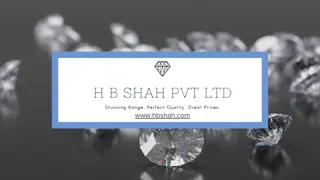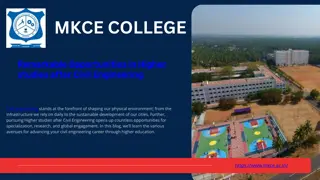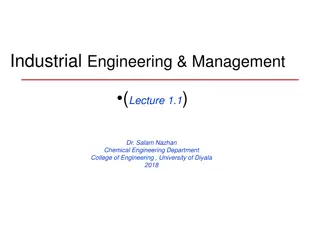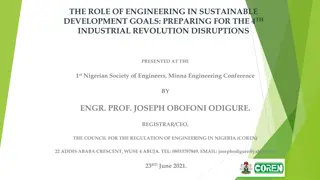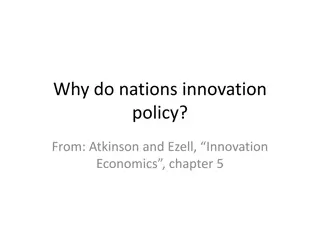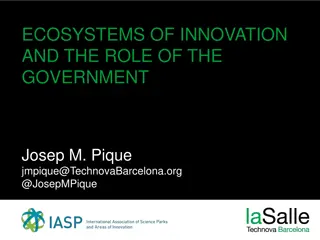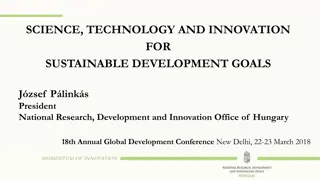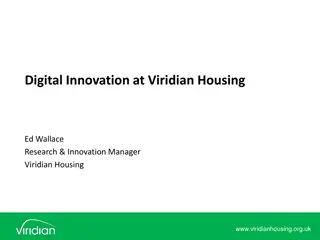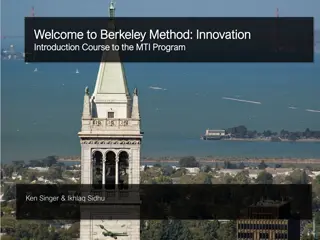Sustainable Development and Innovation in Industrial Engineering
Sustainable development is crucial for meeting human needs while preserving natural resources. Innovations in industrial engineering play a vital role in achieving sustainable development goals. User-driven innovation emphasizes consumer involvement in product creation and customization, leading to more tailored solutions. This comprehensive approach aims to balance economic growth with environmental and social responsibility, ensuring a viable future for generations to come.
Download Presentation

Please find below an Image/Link to download the presentation.
The content on the website is provided AS IS for your information and personal use only. It may not be sold, licensed, or shared on other websites without obtaining consent from the author. Download presentation by click this link. If you encounter any issues during the download, it is possible that the publisher has removed the file from their server.
E N D
Presentation Transcript
Creation and development of new products including sustainable development Agnieszka Ociepa-Kubicka, Katarzyna Rozpondek Curriculum Development of Master s Degree Program in Industrial Engineering for Thailand Sustainable Smart Industry
Sustainable development Sustainable development is the organizing principle for meeting human development goals while simultaneously sustaining the ability of natural systems to provide the natural resources and ecosystem services based upon which the economy and society depend. The desired result is a state of society where living conditions and resources are used to continue to meet human needs without undermining the integrity and stability of the natural system. Sustainable development can be defined as development that meets the needs of the present without compromising the ability of future generations to meet their own needs.
Sustainable Development Goals Source: https://en.unesco.org/sustainabledevelopmentgoals
Sustainable development is the basis of ecological innovations ENVIROMENT a viable natural environment SOCIAL nurturing community ECONOMIC sufficient economy
Innovations Something better? Something cheaper? Something different? Made elsewhere? What are innovations? Made at another time? Something new?
Innovations The term 'innovation' refers to creating something new, therefore most often, innovation is defined as a process consisting of transforming existing possibilities into new ideas and putting them into practical application. According to the Oslo Manual (the international methodological handbook for statistical surveys of innovation recommended in OECD and EU countries), innovation is the implementation of: a new or significantly improved product (product or service), a new or significantly improved process, a new marketing method or a new method of organization in the field of business practices, workplace organization or relations with the external environment.
User Driven Innovation User Driven Innovation is based on the belief that consumers (users) have an increasing impact on the commercial offer available - they participate in the process of creating the products and services they purchase. The User Driven Innovation concept focuses on the needs of users (consumers), who are becoming more and more demanding, but also prefer solutions created individually for them (users should be understood not only of individual consumers, but also enterprises and institutions). User Driven Innovation can be defined as a process of using users' knowledge to develop new products and services. It is important to discover the hidden needs of consumers. They can express their ideas, concepts and design solutions for products, and thus be a source of innovation
User Driven Innovation Under the User Driven Innovation concept, two approaches can be identified that determine the position of the consumer in the innovation process: Consumer voice - focuses on discovering the needs of consumers and using their comments to improve existing products / services on the market Consumer guidance - characterized by search and developing new ideas from consumers
Differences between the traditional approach to innovation and User Driven Innovation Name Traditional method User-Driven Innovation method A place to create innovation In company In company Outside (support from consulting companies) Purpose of the process Identification of consumer needs Identification of consumer needs Identification of solutions Product development using marketing methods Characteristic Consumer voice Consumer guidance Focus on the product - observation, identification of consumer needs - brainstorm - prototypes and solutions - regular testing and implementation Strategic approach (organization of work using new ways) - providing new experiences to clients and employees - infrastructure development and opportunities to raise an innovation culture Cooperation with the consumer on new ideas: - creating a product-service development platform - company development and initiating the cooperation process on better solutions Searching for innovation leaders or identifying leaders: outside - to prepare prototypes and test and create solutions Segmentation, statistics (consumer surveys regarding their needs) - prototypes - tests Methods / Processes Examples P&G, HP Intel, Electrolux Adidas, Lego Mircorost, 3M
Eco-innovation Watch the video "What does eco-innovation mean for you?" Which of the definitions presented best reflects the concept of eco-innovation? Justify your choice. Source: EU Environment, https://www.youtube.com/watch?v=hcMIMUiqVF0
Eco-innovation Definition of innovation generally applies to eco-innovation. Eco-innovation,however, has two further significant, distinguishing characteristics: It is innovation that reflects the concept s explicit emphasis on a reduction of environmental impact, whether such an effect is intended or not. It is not limited to innovation in products, processes, marketing methods and organisational methods, but also includes innovation in social and institutional structures Eco-innovation and its environmental benefits go beyond the conventional organisational boundaries of the innovator to enter the broader societal context through changes in social norms, cultural values and institutional structures. Source: Framework, Practices and Measurement, Synthesis Report, OECD2009 SUSTAINABLE MANUFACTURING AND ECO-INNOVATION
Dimensions of eco-innovation Target Mechanism Impact
The typology of eco-innovations Higher potential environmental benefits but more difficult to co- ordinate Institutions Eco-innovation targets Organisations and marketing methods Primarialy non-technical change Processes and products Primarialy non-technical change Modification Re-design Alternatives Creation Eco-innovation mechanisms
Target Target refers to the basic focus of eco-innovation. Following the Oslo Manual, the target of an eco-innovation may be: Products involving both goods and services. Processes such as a production method or procedure. Marketing methods, for the promotion and pricing of products, and other market oriented strategies. Organizations, such as the structure of management and the distribution of responsibilities. Institutions, which include the broader societal area beyond a single organization's control, such as institutional arrangements, social norms and cultural values. Source: Framework, Practices and Measurement, Synthesis Report, OECD2009 SUSTAINABLE MANUFACTURING AND ECO-INNOVATION
Mechanism Mechanism relates to the method by which the change in the eco-innovation target takes place or is introduced. It is also associated with the underlying nature of the eco-innovation whether the change is of a technological or non-technological character. Four basic mechanisms are identified: Modification, such as small, progressive product and process adjustments. Re-design, referring to significant changes in existing products, processes, organisational structures, etc. Alternatives, such as the introduction of goods and services that can fulfill the same functional need and operate as substitutes for other products. Creation, the design and introduction of entirely new products, processes, procedures, organizations and institutions. Source: Framework, Practices and Measurement, Synthesis Report, OECD2009 SUSTAINABLE MANUFACTURING AND ECO-INNOVATION
Impact Impact refers to the eco-innovation s effect on the environment, across its lifecycle or some other focus area. Potential environmental impacts stem from the eco-innovation s target and mechanism and their interplay with its socio-technical surroundings. Given a specific target, the potential magnitude of the environmental benefit tends to depend on the eco-innovation s mechanism, as more systemic changes, such as alternatives and creation, generally embody higher potential benefits than modification and re-design. Source: Framework, Practices and Measurement, Synthesis Report, OECD2009 SUSTAINABLE MANUFACTURING AND ECO-INNOVATION
Examples of measures of eco-innovation research Analysis level Eco-innovation process Eco-innovation potential Country state policy environmental education and awareness international connections technological development ecological awareness scale resource availability Industry the scale of corporate social responsibility and commitment to pro-innovation activities reduction of negative impact on the environment scale of innovation in industry eco-innovation costs benefits of eco-innovation Business marketing cooperation with ecological organizations technological and other benefits reduction of environmental fees innovation costs profits made and other benefits from eco-innovation development opportunities eco-innovative activities Product product changes and improvements changes in manufacturing processes reduction of negative impact on the environment innovation costs profits made and other benefits of eco-innovation opportunities for developing eco-innovative activities
Products and customers at the heart of circular economy loops row materials Design products Sharing renting, symbiosis, PSS, P2P models Repair fix-it shops, at-home maintenance Re-use customers collection and redistribution Remanufacturing Recycling collection and re-manufacturing collection and recycling Based on: O Brien M., Doranova A., Kably N., Kong M. A., Kern O., Giljum S., G zet B., Eco-Innovation of products: Case studies and policy lessons from EU Member States for a product policy framework that contributes to a circular economy, Biannual Report 2018.
Product eco-innovation for the circular economy spans incremental to systemic change CHANGE Doing better with less (Sustainable production and consumtion) Doing better (Environmental technologies) Doing more with less (Resource efficiency) Degree of change Clean- up the environment, tipically end-of-pipe type inovations Product Eco-innovation Focus on improving products and processes Focus on providing radically new products and services e.g. repair services and producs from recycled materials e.g. closed loop product service systems Circular economy examples e.g. new recycling technologies Integraating environmental management into business models Adapting and improving business models Business implications New business models Source: O Brien M., Doranova A., Kably N., Kong M. A., Kern O., Giljum S., G zet B., Eco-Innovation of products: Case studies and policy lessons from EU Member States for a product policy framework that contributes to a circular economy, Biannual Report 2018.
Framework for monitoring and evaluation of product eco-innovation for the circular economy Three main areas and associated indicators that effect the circularity of a product: Business model: factors applied in business models to ensure the full circularity potential of a product e.g. establishment of take back schemes, application of extended producer responsibility (EPR), integration of circular product design and production into business models, etc. Product design and production: product design and manufacturing elements that influence the circularity potential of the product from a technical perspective e.g. durability, reparability, recyclability, type of materials used, efficient production processes in terms of less resources used and waste produced, etc. Use and post-consumption: consumer behavior elements that contribute towards close looped product cycles e.g. innovative consumption models, longer use of products, recycling, etc. Source: O Brien M., Doranova A., Kably N., Kong M. A., Kern O., Giljum S., G zet B., Eco- Innovation of products: Case studies and policy lessons from EU Member States for a product policy framework that contributes to a circular economy, Biannual Report 2018.
Ecoproduct design The rapid development of industry has caused the need for greater than before care for the environment - hence the growing popularity of environmental management systems. Today the sustainable, conscious and responsible design applies to each industry and to each field of economy.
Basic definitions Product design means a set of processes transforming legal, technical, safety, functional, market and other requirements to be met by a given product in the technical specification of that product. Environmental aspect means an element or function of a given product that may interact with the environment during the product's life cycle. Environmental impact means any change in the environment, wholly or partly, resulting from the operation of a product during its life cycle.
Basic definitions The product life cycle means the successive and interconnected stages of a product's life, from the use of the raw material to the final disposal. Improving the environmental performance means the process of improving the environmental performance of a given product with respect to subsequent generations of the product, although not necessarily covering all environmental aspects of the product at the same time. Ecodesign means taking environmental aspects into account when designing a product in order to improve environmental issues throughout its entire life cycle.
Watch the film Available on youtube How product design can change the world | Christiaan Maats | TEDxUniversityofGroningen https://www.youtube.com/watch?v=ZqeA_psKn2E
Eco design Eco design assumes a new approach to the design of a product with special consideration for the environmental impacts of the product during its whole life cycle. Eco-design is seen as: The philosophy of designing physical objects, the built environment, and services to comply with the principles of social, economic, and ecological sustainability. It aims to offer new solutions that are profitable, attractive and which lead to an overall reduction in the consumption of materials and energy. Based on: O Brien M., Miedzinski M., Giljum S., Doranova A., Eco-innovation and Competitiveness Enabling the transition to a resource-efficient circular economy Annual Report 2013, European Union, 2014.
Eco design The first examples of what is now known as eco-design were recorded in the early 1990s, although more formal steps were taken a few years later. Eco-designing also functions under other names such as: ecological design, design for the environment DfE , green design, sustainaible product design, life cycle design
Eco design The designing should be prudent, aware, responsible - these are the basic assumptions of the ecological design thanks to which eco-design ensures development, does not lead to its destruction, does not cause enormous damage to human and to the planet. The supporters emphasize that you should think about the product in the context of the entire process of its creation - from the purchase of raw material, through the production and the usage of the ready product. Improving the quality of life for millions of people should not and does not have to go hand in hand with the ever-increasing consumption of goods and waste production.
Eco design This is a clear link to the circular economy model as it means that each phase of the product life cycle (including raw materials, production, distribution, use, re- use, re-manufacturing, recycling and disposal) is taken into consideration in the design of a product. Eco design is an early step in an innovation process that explicitly aims at developing an eco-innovative product. The concept of eco design has been evolving from a focus on single aspects of the product, like energy consumption, to a more holistic, life-cycle approach. In application of the concept of Eco design is still rather narrow. practice, however, the Based on: O Brien M., Miedzinski M., Giljum S., Doranova A., Eco-innovation and Competitiveness Enabling the transition to a resource-efficient circular economy Annual Report 2013, European Union, 2014.
Selected features of eco design Fewer materials Manufacturing using fewer materials and less energy. This protects resources and reduces emissions. Easy to recycle Ensuring easy disassembly means using materials that are easily identified, reused or recycled. Use of bio-materials Using a single type of material or a biodegradable material is best, whether natural or a derivative. Lowering emissions Products should be of a suitable size to save material and fuel consumption during transport to reduce CO2emissions. Long-lasting Shapes and sustainable materials should be long-lasting, maximising the useful life of the product. Multipurpose, reusable and recyclable Products should have multiple uses, be suitable for reuse, and be manufactured with recyclable materials. Green message Sustainable design spreads the idea of sustainability with messages intrinsic to the product itself. Innovative Technological innovations can optimise product efficiency and sustainability. Source: https://www.iberdrola.com/social-commitment/eco-design-sustainable-products
Selected benefits of eco design HIGHER QUALITY PRODUCTS Eco-design products are more versatile and are manufactured with longer lasting materials. MORE SUSTAINABLE INDUSTRIES Companies benefit from innovation and become more committed to the environment. MORE EFFICIENT PRODUCTION They save energy and require fewer natural resources and raw materials. HAPPIER CONSUMERS Consumers needs are met with more attractive products that satisfy an increasingly demanding public. MARKET DIFFERENTIATION Sustainable products have added value hat gives them an edge over competitors. FEWER EMISSIONS They consume less energy during transport for lower CO2 emissions. Source: https://www.iberdrola.com/social-commitment/eco-design-sustainable-products
Product A product is a collection of physical and non-physical features that the seller offers and acquires to the buyer, thus accepting the properties of a given good or service. So the product is everything that can be offered on the market. That is, every good and service that can be purchased, used or consumed, thus satisfying human needs. The product can therefore be exchanged. Each product has specific features that make it stand out from others. It can be described and named. There are usually many goods on the market that meet one need but have different brands and differ in many features (for example, packaging, shape, size, species or production technology). Therefore, they constitute separate market products.
Features of the new product COST REDUCTIONS NEW-TO-THE-WORLD PRODUCT New products allowing the company to enter the market. Products with similar functions at lower costs. 01 06 NEW CATEGORY PRODUCTS PRODUCT REPOSITIONING 05 02 New products allowing the company to enter the existing market for the first time. Existing products targeted at new markets or new market segments. 04 03 PRODUCT LINE EXTENSIONS PRODUCT IMPROVEMENTS New products complementing the company's existing product lines. New performance or greater perceived value, replacing existing products. products with improved
Recycling- the second life of materials Eco design often uses recycled items, i.e. recycled materials. Recycling is widely used in the construction and the interior design. Arrangements include demolition bricks and wood from demolished buildings, as well as excavated stones. In the interiors, these materials are extremely fashionable. They can also be used in the construction of a building. The advantage of using recycled materials is that they are, they do not need to be manufactured, and thus we do not pollute the environment during their production.
Recycling- the second life of materials Nowadays many creators try to meet the principles of eco-design. Often with surprisingly good results. The Dutch studio Hergebruik (ang. Re-use) gathers artists who create in an ecological way. New objects are created using old materials and waste. What seemed useless and worthless turns out to be an inspirational material. Old bicycle tire, broken keyboard keys, plywood, banner advertising while seeing the results of their work, using these "rubbish", it is necessary to redefine the terms "valuable", "worthless", "useful", "useless". In the studio's store, you can find a diverse collection of products and articles, from clothes, bags, lamps, porcelain to furniture. The understanding and implementation of the terms "re-use", "re-cycle", "re- make", "re-search" by the artists of this Dutch studio is extremely inspiring.
Recycling- the second life of materials The German designer Franziska Wodicka also deals with extending the life of worn objects. In her shop in the Kreuzberg district of Berlin, the artist collects old drawers, creating unique and as she admits, well-selling furniture. He assembles the old drawers in new housings constructed of veneer boards or solid wood. Drawers can be admired in all colours and sizes. The effect is absolutely unpretentious.
Eco design in art Eco design in art has been used since the beginning of the 20th century. Pablo Picasso and Georges Braque created collages including from the used packaging. Inspirations with eco design are also visible in the contemporary art.
Above all, man For sustainable design, the man is extremely important in creating products. This is clearly seen in the activities of the California Artecnica studio and their project "design with conscience". The studio promotes cooperation of leading designers with small, local craftsmen. Thanks to this, projects are implemented using environmentally and human-friendly methods and natural products. The studio sets the bar high: they want to generate a better and more human world, support local craftsmen and combat child abuse. One of their initiatives is the production of lamps, made by women living in the R o de Janeiro slums, who can work at home while looking after their children.
Watch the film Available on youtube Nature Eco Products documentary https://www.youtube.com/watch?v=DBTR6L0zaPA
Sustainable design certification There are specific regulations governing eco-design that certify the sustainable products launched in the market. There are three certifications: Cradle to Cradle (C2C): this system certifies and fosters innovation in sustainable products across five critical performance categories: material health, material reutilisation, renewable energy and carbon management, water stewardship, and social fairness. ISO 14062: this international environmental standard assesses integration of environmental aspects into product design and development. ISO 14001: This standard enables companies to certify their commitment to the environment by managing the ecological hazards intrinsic to their activities.
Thank You Together We Will Make Our Education Stronger https://msie4.ait.ac.th/ @MSIE4Thailand MSIE 4.0 Channel Curriculum Development of Master s Degree Program in Industrial Engineering for Thailand Sustainable Smart Industry






